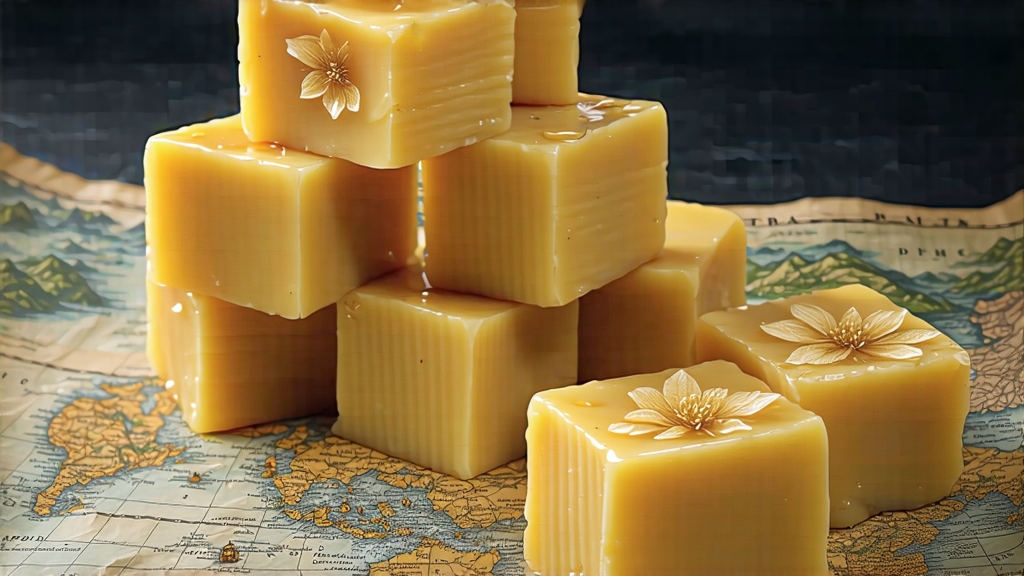
If black tea is the dark knight of the Camellia sinensis family, then Fu brick (Fú zhuān, 茯砖) is its alchemist—quietly turning leaf, steam and time into a luminous amber liquor that once served as currency along the caravan tracks of Central Asia. Compressed into obsidian-black slabs shot through with canary-yellow freckles, this sub-category of Chinese dark tea (hēi chá) carries within its tight matrix a living constellation of Eurotium cristatum spores—known in trade argot as “golden flowers” (jīn huā). To the uninitiated the bloom looks like mildew; to the connoisseur it is the signature of a tea that has literally fermented inside its own brick walls while marching a thousand kilometres westward on camelback. This essay invites the global reader to unwrap that brick, smell its cellared apricot aroma, and understand why, for fourteen centuries, nomads and emperors alike have traded horses, furs and even princesses for its calming, butter-sweet infusion.
-
Historical footprint: from imperial decree to prairie pantry
Chronicles place the first purposely fermented dark bricks during the late Tang (618-907 CE), when military garrisons in today’s Hunan province bartered compressed tea for Mongolian warhorses. Yet the “Fu” nomenclature itself surfaces only in 1368, the inaugural year of the Ming dynasty, when the imperial Tea-Horse Office established the “Fu Tea Bureau” in Jingyang county, Shaanxi. The character Fu (茯) is a deliberate homophone of “Fu” (服, to submit), hinting at the court’s political hope that frontier tribes would “submit” once hooked on the brew. Caravans departing Xi’an carried two cargo types—silk rolls and tea bricks—protected from Himalayan cold by felt blankets that incidentally incubated a slow, secondary fermentation. By the Qing (1644-1911) the bricks had become legal tender on the steppe; Kazakh herdsmen paid taxes in fu bricks, and Tibetan monks measured monastic wealth by the stack. When the Trans-Siberian Railway opened in 1903, Cossack soldiers introduced fu brick to Moscow, where it survives today as the samovar staple “kirpichny chai” (brick tea). -
Terroir and leaf pedigree: why Hunan smokes and Shaanxi sweetens
Modern Chinese standards (GB/T 9833.3-2013) recognise two legally protected origins:
a) Hunan Fu Brick—manufactured in Yiyang’s Anhua county from a large-leaf cultivar called Yun-Tai (#云台大叶种). The humid, fog-locked valleys generate a higher ratio of polyphenols, yielding a deep tobacco note and a menthol-like cooling finish.
b) Shaanxi Fu Brick—produced in Jingyang and Xianyang from a medium-leaf Qin-Cha (#秦茶群体种) strain kissed by the loess plateau’s big diurnal swing. The result is lighter in colour, sweeter on palate, and prized for its larger golden flowers.
Although both styles are collectively marketed as “Fu brick,” experienced cuppers can blind-identify them: Hunan bricks smell of pine-smoke and wet slate; Shaanxi bricks recall dried longan and marzipan. -
Crafting the brick: a four-season choreography
Step 1 – withering under the moon
Leaves are spread 5 cm deep on bamboo racks for 6–8 hours during the night, leveraging the plateau’s radiant cooling to lock in floral precursors while moonlight suppresses photo-oxidation of catechins.
Step 2 – piling the “wet stack”
The semi-dry leaves are sprayed with 28 % moisture water (pH 7.2, drawn from 80 m wells) and piled 70 cm high. Thermophilic bacteria raise the core temperature to 55 °C within 24 h; every 48 h the pile is turned, mimicking a compost choreography that reduces bitterness and births the first hints of β-damascone—the same aroma molecule found in baked apples.
Step 3 – primary compression
After 15 days the leaf is steam-softened at 102 °C for 8 seconds, then fed into a century-old, cast-iron screw press that exerts 50 metric tonnes of pressure for 90 minutes, squeezing the pile into a 2 kg